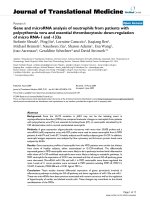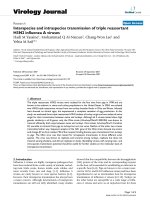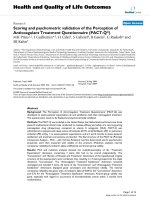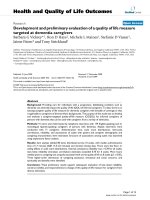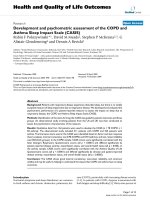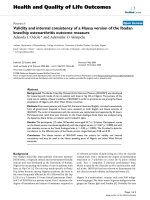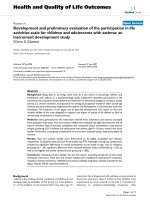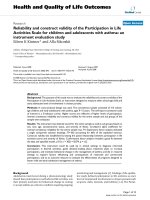Báo cáo hóa học: " Interspecies and intraspecies transmission of triple reassortant H3N2 influenza A viruses" pptx
Bạn đang xem bản rút gọn của tài liệu. Xem và tải ngay bản đầy đủ của tài liệu tại đây (343.96 KB, 9 trang )
BioMed Central
Page 1 of 9
(page number not for citation purposes)
Virology Journal
Open Access
Research
Interspecies and intraspecies transmission of triple reassortant
H3N2 influenza A viruses
Hadi M Yassine
1
, Mohammad Q Al-Natour
2
, Chang-Won Lee
1
and
Yehia M Saif*
1
Address:
1
Food Animal Health Research Program, Ohio Agricultural Research and Development Center, The Ohio State University, Wooster OH,
USA and
2
Department of Pathology and Animal Health, Faculty of Veterinary Medicine, Jordan University of Science and Technology, Irbid, Jordan
Email: Hadi M Yassine - ; Mohammad Q Al-Natour - ; Chang-Won Lee - ;
Yehia M Saif* -
* Corresponding author
1. Abstract
The triple reassortant H3N2 viruses were isolated for the first time from pigs in 1998 and are
known to be endemic in swine and turkey populations in the United States. In 2004, we isolated
two H3N2 triple reassortant viruses from two turkey breeder flocks in Ohio and Illinois. Infected
hens showed no clinical signs, but experienced a complete cessation of egg production. In this
study, we evaluated three triple reassortant H3N2 isolates of turkey origin and one isolate of swine
origin for their transmission between swine and turkeys. Although all 4 viruses tested share high
genetic similarity in all 8 genes, only the Ohio strain (A/turkey/Ohio/313053/04) was shown to
transmit efficiently both ways between swine and turkeys. One isolate, A/turkey/North Carolina/
03, was able to transmit from pigs to turkeys but not vice versa. Neither of the other two viruses
transmitted either way. Sequence analysis of the HA1 gene of the Ohio strain showed one amino
acid change (D to A) at residue 190 of the receptor binding domain upon transmission from turkeys
to pigs. The Ohio virus was then tested for intraspecies transmission in three different avian
species. The virus was shown to replicate and transmit among turkeys, replicate but does not
transmit among chickens, and did not replicate in ducks. Identifying viruses with varying inter- and
intra-species transmission potential should be useful for further studies on the molecular basis of
interspecies transmission.
2. Introduction
Influenza A viruses are highly contagious pathogens that
have been isolated form a wide variety of animals, includ-
ing man, birds, swine, horses, minks, seals, whales, and
most recently from cats and dogs [1-3]. Influenza A
viruses are rarely known to cross species barriers [4,5],
however, their interspecies transmission has always been
a major concern. Although determinants of interspecies
transmission are still not fully identified, many studies
showed that the compatibility between the hemagglutinin
(HA) protein of the virus and its corresponding receptor
on the host cell is essential for establishing an infection in
a specific host [6-8]. Pigs are known to be a major reser-
voir for H1N1 and H3N2 influenza viruses and have been
hypothesized to act as intermediate host for interspecies
transmission of influenza A viruses [6,9,10]. Turkeys on
the other hand, are susceptible to a wide range of influ-
enza A viruses and serve as an important host for these
Published: 28 November 2007
Virology Journal 2007, 4:129 doi:10.1186/1743-422X-4-129
Received: 24 September 2007
Accepted: 28 November 2007
This article is available from: />© 2007 Yassine et al; licensee BioMed Central Ltd.
This is an Open Access article distributed under the terms of the Creative Commons Attribution License ( />),
which permits unrestricted use, distribution, and reproduction in any medium, provided the original work is properly cited.
Virology Journal 2007, 4:129 />Page 2 of 9
(page number not for citation purposes)
viruses [11,12]. Influenza infections in turkeys range from
asymptomatic to severe disease, including respiratory tract
disorder, depression, drop in eggs production and high
mortality [11]. Between 1978 and 1981, our laboratory
was the first to report on experimental and natural infec-
tions of turkeys with H1N1 swine influenza viruses
[13,14].
In 1998, a new lineage of swine influenza viruses, triple
reassortants (TR) H3N2, were isolated for the first time
from pigs in the United States (U.S.) [15]. These viruses
had genes derived from human (HA, NA, and PB1), Swine
(NP, M, and NS) and avian viruses (PA and PB2) [16,17].
The H3N2 TR viruses are now endemic in swine popula-
tions in North America [17,18]. In 2003 and 2004, similar
viruses (H3N2 TR) were isolated from turkeys in two dif-
ferent locations in the U.S. [19,20]. Later in the same year,
we isolated another H3N2 TR virus from turkey breeder
hens in Illinois that were vaccinated twice with a swine
H3N2 TR virus. Infected turkeys experienced complete
cessation of egg production, but had no other clinical
signs. In a previous study (manuscript submitted) we
observed major antigenic differences between turkey and
swine H3N2 TR viruses. The antigenic relatedness (R-
value) between the turkey viruses and the swine virus
(vaccine strain) was less than 30% as expressed by the
Archetti and Horsfall formula [21] based on hemaggluti-
nin inhibition (HI) and virus neutralization (VN) tests. At
least eight amino acid changes were observed at the anti-
genic sites of the HA1 molecule between the turkey viruses
and the swine vaccine virus. Although the transmission of
H3N2 TR viruses from pigs to turkeys was suggested in
previous reports [19,20], no experimental work has been
done to support this premise. Hence, we initiated this
study to evaluate the interspecies transmission of these
viruses between swine and turkeys, and to determine at
the molecular level the basis for such transmission. Addi-
tionally, we tested one strain, A/turkey/Ohio/313053/04,
that was shown to transmit between swine and turkeys for
its intraspecies transmission in turkeys, chickens and
ducks. Identifying viruses with different transmission
potential between swine and turkeys will help in identify-
ing the molecular determinants that control such trans-
mission using the reverse genetics techniques.
3. Results
3.1 Interspecies transmission of H3N2 influenza viruses
from pigs to turkeys
Three H3N2 influenza isolates of turkey origin and one
H3N2 influenza isolate of swine origin were evaluated for
their transmission from pigs to turkeys. Additionally, two
H1N1 isolates of swine and turkey origins were included
for comparison. All viruses were shown to replicate in pigs
but with different efficiencies (Table 1). The A/turkey/
Ohio/313053/04 and A/turkey/North Carolina/03
viruses replicated more efficiently than the other H3N2
viruses, with nasal swab titer of 2 × 10
6
and 2 × 10
6.6
50%
tissue culture infectious dose (TCID
50
) per ml, respec-
tively (Table 1). The H1N1 turkey strain, A/turkey/Ohio/
88, showed the highest replication titer (2 × 10
8.1
TCID
50
/
ml) among all viruses tested. The Ohio strain, A/turkey/
Ohio/313053/04, elicited the highest antibody titer
(1:360 HI) among all the H3N2 viruses tested (Table 1).
Different patterns of transmission from pigs to turkeys
were observed among the H3N2 TR viruses (Table 2). The
H3N2 Ohio strain was transmitted from pigs to turkeys
and virus was detected for more than two days in turkeys
using the real-time reverse-transcription PCR (RRT-PCR).
Four out of the eight contact turkeys got infected and three
of them seroconverted to an average HI titer of 1:80. The
Table 1: Interspecies transmission of H3N2 and H1N1 influenza viruses from pigs to turkeys; virus detection in inoculated pigs
Virus No.
positives 1
to 3 DPI*
No.
positives
4 to 6 DPI
No. positives
for 2 or
more days
Peak day
of virus
detection
Estimated
average virus titer
on peak day/ml
No. of animals
seroconverted/
total inoculated
HI****
average titer
at 14 DPI
Virus
isolation
from swab
samples
A/TK/IL/04
(H3N2)
5/5** 3/3*** 5/5 4DPI 2 × 10
4.5
3/3 1:160 Positive
A/TK/OH/04
(H3N2)
5/5 4/4*** 5/5 5DPI 2 × 10
6.0
4/4 1:360 Positive
A/TK/NC/03
(H3N2)
5/5 4/4*** 5/5 4DPI 2 × 10
6.6
4/4 1:220 Positive
A/SW/NC/
03 (H3N2)
5/5 3/3*** 5/5 4DPI 2 × 10
4.7
3/4 1:340 Positive
A/TK/OH/88
(H1N1)
5/5 4/4*** 5/5 4DPI 2 × 10
8.1
4/4 1:320 NT
A/SW/OH/
06 (H1N1)
5/5 4/4*** 5/5 4DPI 2 × 10
5.6
4/4 1:160 NT
* Days post inoculation. Swabs were collected on daily bases and results are displayed in three days intervals.
** No. of pigs positive with RRT-PCR/No. of pigs inoculated.
*** Some pigs were euthanized at 3 DPI to collect organs and tissues for other studies.
**** Hemagglutinin inhibition.
NT Not Tested
Virology Journal 2007, 4:129 />Page 3 of 9
(page number not for citation purposes)
A/turkey/North Carolina/03 virus was detected in three
out of eight contact turkeys using the RRT-PCR, with one
turkey detected positive for two days; however, none of
the infected turkeys seroconverted. Viruses were success-
fully re-isolated using Madin-Darby Canine Kidney
(MDCK) cells from the contact turkeys infected with A/
turkey/Ohio/313053/04 and A/turkey/North Carolina/03
H3N2 viruses. On the other hand, although three out of
eight and four out of eight swab samples were AIV-posi-
tive with RRT-PCR at two days post exposure (DPE) from
turkeys in contact with pigs infected with A/turkey/Illi-
nois/04 and A/swine/North Carolina/03, respectively, no
viruses were isolated from any of the RRT-PCR positive
samples and none of the turkeys seroconverted (Table 2).
Both H1N1 viruses replicated in pigs, but none of them
were detected in the contact turkeys as determined by
RRT-PCR and HI tests.
3.2 Interspecies transmission of H3N2 influenza viruses
from turkeys to pigs
We also evaluated the transmission of the H3N2 viruses
from turkeys to pigs (Tables 3 and 4). As expected, all
H3N2 viruses replicated in turkeys regardless of their iso-
lation origin and were detected in the inoculated turkeys
for at least six days, except for the A/swine/North Caroil-
ina/03 virus that was detected for only four days. In gen-
eral, the swab viral titers were lower than that from pigs,
ranging from 2 × 10
2.8
to 2 × 10
3.3
TCID
50
/ml. Again, the
Ohio and North Carolina turkey isolates replicated at the
highest titers of 2 × 10
3.3
TCID
50
/ml. All viruses were
shown to elicit antibody response in turkeys with the
highest titer observed against the Ohio strain at 1:420 HI.
Only the Ohio strain transmitted from the infected tur-
keys to the contact pigs as determined by RRT-PCR, HI test
and virus isolation (Table 4). The first positive pig was
detected at the 3 DPE, and the rest became positive at 5
Table 3: Interspecies transmission of H3N2 influenza viruses from turkeys to pigs; virus detection in inoculated turkeys
Virus No.
positives 1
to 3 DPI*
No.
positives
4 to 6 DPI
No.
positives
7 to 9 DPI
No.
positives
for 2 or
more days
Peak day
of virus
detection
Estimated
average
virus titer on
peak day/ml
No. of animals
seroconverted
/total
inoculated
HI***
average
titer at
14DPI
Virus
isolation from
swab samples
A/TK/IL/04
(H3N2)
6/10** 7/10 NT 8/10 5DPI 2 × 10
2.9
9/10 1:300 Positive
A/TK/OH/
04 (H3N2)
7/10 5/10 2/10 8/10 4DPI 2 × 10
3.3
4/6 1:420 Positive
A/TK/NC/
03 (H3N2)
6/10 6/10 NT 6/10 4DPI 2 × 10
3.3
3/10 1:80 Positive
A/SW/NC/
03 (H3N2)
4/10 1/10 0/10 3/10 3DPI 2 × 10
2.8
2/10 1:80 Positive
* Days post inoculation. Swabs were collected on daily bases and results are displayed in three days intervals.
** No. of turkeys positive with RRT-PCR/No. of inoculated turkeys.
*** Hemagglutinin inhibition.
NT Not Tested
Table 2: Interspecies transmission of H3N2 and H1N1 influenza viruses from pigs to turkeys; virus detection in turkeys in contact with
inoculated pigs
Virus No.
positives 1
to 3 DPE*
No.
positives 4
to 6 DPE
No.
positives 7
to 9 DPE
No.
positives
for 2 or
more days
Peak day
of virus
detection
Estimated
average
virus titer on
peak day/ml
No. of animals
seroconverted
/total exposed
HI***
average
titer at
14 DPE
Virus
isolation from
swab samples
A/TK/IL/04
(H3N2)
3/8** 0/8 0/8 0/8 2DPE 2 × 10
3
0/8 - Negative
A/TK/OH/
04 (H3N2)
0/8 4/8 2/8 3/8 6DPE 2 × 10
3.12
3/8 1:80 Positive
A/TK/NC/
03 (H3N2)
0/8 2/8 1/8 1/8 5DPE 2 × 10
3.8
0/8 - Positive
A/SW/NC/
03 (H3N2)
4/8 0/8 0/8 0/8 2DPE 2 × 10
3
0/8 - Negative
A/TK/OH/
88 (H1N1)
0/8 0/8 0/8 - - - - - NT
A/SW/OH/
06 (H1N1)
0/8 0/8 0/8 - - - - - NT
* Days post exposure. Swabs were collected on daily bases and results are displayed in three days intervals.
** No. of turkeys positive with RRT-PCR/total No. of contact turkeys.
*** Hemagglutinin inhibition.
NT Not Tested
Virology Journal 2007, 4:129 />Page 4 of 9
(page number not for citation purposes)
DPE. All pigs infected with the Ohio strain seroconverted
with an average HI titer of 1:320.
3.3. Sequence analysis
The two surface glycoproteins encoding genes, HA and
NA, were amplified and sequenced from A/turkey/Ohio/
313053/04 H3N2 virus isolated from directly inoculated
pigs, pigs in contact with infected turkeys, directly inocu-
lated turkeys and turkeys in contact with infected pigs.
Pairwise sequence alignment showed two changes in the
HA gene sequence upon replication and transmission of
the virus from pigs and turkeys. The first change was
observed at residue 190 (D to A) of the receptor binding
domain (RBD) in viruses isolated from pigs in contact
with infected turkeys (Figure 1). The other change was
observed at residue 246 (S to N) in two of the inoculated
pigs and one of the turkeys in contact with inoculated pigs
(Figure 1). No changes were observed in the NA gene
upon replication and transmission of the virus from pigs
to turkeys and vise versa.
3.4. Intraspecies transmission of A/turkey/Ohio/313053/04
H3N2 virus in turkeys, chickens and ducks
To evaluate the transmission potential of H3N2 viruses in
different avian species, we tested the intraspecies trans-
mission of A/turkey/Ohio/313053/04 virus (strain that
showed efficient transmission between pigs and turkeys)
in turkeys, chickens and ducks (Table 5). The virus
behaved differently in different avian species, where it was
capable of replication in turkeys and chickens, but not in
ducks. Although the replication titers in chickens were
higher than those in turkeys, 2 × 10
6
and 2 × 10
3.4
TCID
50
/
ml, respectively, no transmission was detected among
chickens. The virus was detected for more than one day in
90% of the inoculated chickens, of which 62% serocon-
verted to an average titer of 1:216 HI. On the other hand,
80% of the inoculated turkeys were positive with RRT-
PCR for influenza virus for more than two days, and all of
them seroconverted to an average HI titer of 1:990. The
very high HI average titer of the turkey serum was due to
two turkeys that showed an HI titer of 5120 and 2560
respectively. Nine of the ten contact turkeys in the same
cage became positive, two of which were positive at 3
DPE, while the rest were positive between 7 DPE and 9
DPE. Only two of the contact turkeys seroconverted to an
HI titer of 1:120 HI units. The delay in infection in most
of the contact turkeys would explain the negative HI tests
(only two of the contact turkeys were positive) that were
performed on serum samples collected at 14 day post
exposure (DPE).
4. Discussion
Generally, influenza A viruses are considered host specific,
nevertheless, some can overcome the species barrier and
infect a new host. The mechanisms by which the influenza
A viruses cross the species barriers and the molecular
determinants that control such transmission are not well
identified. Pigs have been hypothesized to play a role in
interspecies transmission by acting as "mixing vessel" for
the generation of reassortant viruses that might have the
potential to jump from one species to another [22,23]. In
1998, a new lineage of swine viruses, H3N2 TR, emerged
and caused influenza like illnesses in pig populations in
the U.S. [15,16]. Similar viruses were later isolated from
turkey breeder hens experiencing drop in eggs production
and it was hypothesized that these viruses were transmit-
ted from pigs to turkeys [19,20].
Our findings indicated the ability of certain H3N2 TR
viruses to transmit between pigs and turkeys. Despite the
high degree of molecular similarity between some of these
viruses, like A/turkey/Illinois/04 and A/turkey/Ohio/
313053/04 (>99% similarity in all genes), they behaved
differently in the transmission experiments, with the A/
turkey/Ohio/313053/04 transmitting both ways between
Table 4: Interspecies transmission of H3N2 influenza viruses from turkeys to pigs; virus detection in pigs in contact with inoculated
turkeys
Virus No.
positives 1
to 3 DPE*
No.
positives 4
to 6 DPE
No.
positives 7
to 9 DPE
No. positives
for 2 or
more days
Peak day
of virus
detection
Estimated
average
virus titer on
peak day/ml
No. of animals
seroconverte
d/total
exposed
HI***
average
titer at
14DPI
Virus
isolation
from swab
samples
A/TK/IL/04
(H3N2)
0/5** 0/5 0/5 0/5 - - 0/5 - -
A/TK/OH/
04 (H3N2)
1/5 5/5 5/5 5/5 5DPE 2 × 10
5
5/5 1:320 Positive
A/TK/NC/
03 (H3N2)
0/5 0/5 0/5 0/5 - - 0/5 - -
A/SW/NC/
03 (H3N2)
0/5 0/5 0/5 0/5 - - 0/5 - -
* Days post exposure. Swabs were collected on daily bases and results are displayed in three days intervals.
** No. of pigs positive with RRT-PCR/total No. of contact pigs.
*** Hemagglutinin inhibition
Virology Journal 2007, 4:129 />Page 5 of 9
(page number not for citation purposes)
the two species and the A/turkey/Illinois/04 virus not
transmitting either way.
Regardless of the differences in transmission, all viruses
were capable of replication in turkeys and pigs but to dif-
ferent titers. Furthermore, the A/turkey/Ohio/313053/04,
the strain transmissible between pigs and turkeys, was
shown to infect and transmit among turkeys, infect but
did not transmit among chickens, and did not infect
ducks.
We speculate that the H3N2 TR viruses, which have the
HA gene from human lineage viruses, retain the receptor
binding specificity to NeuAcα2,6Gal receptors similar to
human influenza viruses. Val226 and Ser228 were
expressed in the HA1 molecules of both turkey and swine
triple reassortants, while Leu/Ile226 and Ser228 are usu-
ally expressed in the human viruses [24]. Leu, Ile, and Val
are neutral non-polar amino acids, and substitutions
between them most likely maintain the hydrophobic
interactions and the proper conformation at the binding
domain [25]. Gln226 and Gly228 are usually found in the
HA1 molecules of avian viruses amino acids at these posi-
tions and are known to play a critical role in determining
the receptor binding specificity [25]. Our unpublished
work demonstrated the presence of substantial amount of
NeuAcα2,6Gal receptors in turkey tracheas, which would
explain the ability of these viruses to replicate in turkeys
as well as in pigs that are known to express these receptors
[6]. Although ducks were shown to express few
NeuAcα2,6Gal receptors in their tracheas (unpublished
work), the A/turkey/Ohio/313053/04 H3N2 virus was
not able to replicate in ducks. The absence of a large
number of NeuAcα2,6Gal receptors in ducks' tracheas
may explain the inability of the A/turkey/Ohio/313053/
04 H3N2 virus to replicate in ducks. However, there may
be factors other than receptors distribution that contrib-
ute to host tropism of influenza viruses and more work is
needed in this area.
While all viruses had the Asp (D) amino acid at residue
190 of the receptor binding domain (RBD), a D to A (Ala)
change occurred upon the transmission of the A/turkey/
Ohio/313053/04 virus from turkeys to pigs. The presence
of either D (specific for SAα2,6- gal) or E (specific for
SAα2,3- gal) at amino acid position 190 of the HA mole-
cule in the H3 subtypes was reported in previous studies
[26,27], however, our observation of (A) residue at this
position is the first of its kind to our knowledge (sequenc-
ing was performed on the HA gene of the Ohio virus iso-
lated from three different pigs in contact with infected
turkeys). The role of (A) residue at position 190 in deter-
mining receptor binding specificity should be further
investigated. In addition, the role of Asn (N) residue at
position 246 of the HA molecule is not known and will be
further studied in out laboratory.
Although all viruses were shed by pigs for more than 6
days, the A/turkey/Ohio/313053/04 and A/turkey/North
Carolina/03 viruses replicated to higher titers than A/tur-
key/Illinois/04 and A/swine/North Carolina/03 viruses.
This might be one of the possible reasons that allowed A/
Cartoon representing the amino acid changes at the HA mol-ecule of the A/turkey/Ohio/313053/04 H3N2 virus, that occurred upon replication and transmission of the virus between turkeys and pigsFigure 1
Cartoon representing the amino acid changes at the HA mol-
ecule of the A/turkey/Ohio/313053/04 H3N2 virus, that
occurred upon replication and transmission of the virus
between turkeys and pigs. Red: receptor binding domain
(RBD). Yellow: the change at residue 190 that occurred upon
transmission of the virus from turkeys to pigs. Violet: the
change at residue 246 that occured in two of the inoculated
pigs and one of the contact turkeys with inoculated pigs.
Virology Journal 2007, 4:129 />Page 6 of 9
(page number not for citation purposes)
turkey/Ohio/313053/04 and A/turkey/North Carolina/03
viruses to transmit from pigs to turkeys (all animals were
inoculated with the same virus titer). The A/turkey/Illi-
nois/04 and A/swine/North Carolina/03 viruses were
detected only on one day in contact turkeys by RRT-PCR,
however, no viruses were obtained upon isolation
attempts. The high sensitivity of the RRT-PCR might
explain the ability to detect these viruses in contact tur-
keys, whereas the viruses were inefficient in replicating to
a high titer in turkeys. In contrast, the A/turkey/Ohio/
1988 H1N1 virus was shown to replicate to a very high
titer in pigs (10
7.1
TCID
50
), but it did not transmit to tur-
keys. The above observations indicate the specificity of
individual influenza A viruses, even within the same sub-
type (H3N2 TR in this case), in their ability to transmit
between species.
Previous analysis of the A/swine/North Carolina/03 virus
in our laboratory showed that it has a 13 amino acids stalk
deletion in the NA protein (manuscript submitted).
Shortened NA stalks might result in less efficient virus
release, and hence lower virus titers [28,29]. This might
explain our results from pigs and turkeys. However, the
exact effect of NA stalk deletion is not clear because many
chicken adapted H5, H7, and H9 viruses show different
length stalk deletions and replicate to very high titer in
poultry [30-32].
The identification of viruses with varying potential for
interspecies transmission should be useful for reverse
genetic studies to identify the gene(s) and the amino
acid(s) residues that contribute to the transmission of
these viruses between swine and turkeys. The use of the
reverse genetics and site directed mutagenesis could also
be helpful in deciphering the role of residues 190 and 246
of the HA molecule in receptor binding specificity and
transmission of these viruses between swine and turkeys.
Interspecies transmission studies between swine (mam-
malian) and turkeys (avian) will enhance our understand-
ing of the genetic factors that control transmission of
influenza viruses and would help in improvement of sur-
veillance strategies for early detection of influenza A
viruses.
5. Materials and methods
5.1 Viruses
Four H3N2 TR viruses of turkey or swine origin were
included in this study. Additionally, two H1N1 viruses
(one turkey origin and one swine origin) were included
for comparison. Two H3N2 turkey viruses, A/turkey/Illi-
nois/04 and A/turkey/Ohio/313053/04, were isolated in
MDCK cells in our laboratory in 2004, and were propa-
gated in 9–10 days old embryonated chicken eggs (ECE)
to make working stocks. One turkey virus, A/turkey/North
Carolina/03 (H3N2) (passaged twice (P2) in MDCK
cells), and one swine virus, A/swine/North Carolina/03
(H3N2) (unknown passage number), were kindly pro-
vided by Dr. Eric Gonder (Goldsboro Milling Co. Golds-
boro, NC), and were propagated in 9–10 days old ECE to
make working stocks. The turkey H1N1 (A/turkey/Ohio/
1988) and swine H1N1 (A/swine/Ohio/06) viruses were
isolated in ECE in our lab in 1988 and 2006, respectively.
Both viruses were propagated once in ECE to make work-
ing stocks. The two H1N1 influenza viruses were included
as controls for the transmission from pig to turkey, but
not in the turkey to pig transmission study.
5.2 Virus isolation
Turkey tracheal swabs were used for inoculation of MDCK
cell line maintained in Opti-MEM minimum essential
medium (Invitrogen, Grand Island, NY) containing 0.5
μg/ml trypsin. The samples were passaged twice in MDCK
cells and then used to inoculate 9–10 days old specific
pathogen free (SPF) ECE to make working stocks.
Table 5: Intraspecies transmission of A/TK/OH/313053/04 (H3N2) Influenza virus in chickens, ducks and turkeys
Virus TK/
OH/04
(H3N2)
No. positive 1
to 3 DPI/DPE
No. positive 4
to 6 DPI/DPE
No. positive 7
to 9 DPI/DPE
No. positive 10
to 12 DPI/DPE
Peak day
of virus
detection
Estimated
average virus
titer on peak
day/mL
No. of animals
seroconverted/
total exposed
HI
average
titer
Infected
chickens
19/20 10/16* NT NT 2DPI 2 × 10
6
10/16 1:216
Contact
chickens
0/10 0/10 0/10 NT - - 0/10 -
Infected
ducks
0/15 0/15 0/15 NT - - 0/15 -
Contact
ducks
0/15 0/15 0/15 NT - - 0/15 -
Infected
turkeys
13/15 8/10* NT NT 3DPI 2 × 10
3.4
10/10 1:990
Contact
turkeys
2/10 2/10 6/10 7/10 DPI 8DPE 2 × 10
3.5
2/10 1:120
* Some of the inoculated turkeys and chickens were euthanized at 3DPI to collect tracheas for other studie
Virology Journal 2007, 4:129 />Page 7 of 9
(page number not for citation purposes)
5.3 Transmission studies
A schematic layout of the room used for the transmission
studies is presented in Figure 2. The rooms were mechan-
ically ventilated and the air was HEPA filtered at the intake
and the exhaust. Briefly, the infected and contact animals
were placed close to each other in two different cages
(with rubber coated floors) to study the indirect transmis-
sion of H3N2 TR viruses between swine (large white
breed) and specific pathogen free (SPF) turkeys. The direc-
tion of the air current was always from the infected ani-
mals' side to the contact animals' side. The animals
received a virus titer of 10
7
TCID50 contained in 0.5 ml,
and the contact animals were placed in the same room
close to the infected animals at one day post inoculation
(1 DPI). Nasal swabs from pigs and tracheal swabs from
turkeys were collected on daily basis and were maintained
in Brain Heart Infusion (BHI) media and were directly
used for RNA extractions. Contact animals were always
handled first.
Intraspecies transmission experiments with the Ohio virus
(A/turkey/Ohio/313053/04) were performed in SPF tur-
keys, SPF chickens and commercial pekin ducks. The indi-
vidual bird (n = 15 for turkeys and ducks, and n = 20 for
chickens) received a virus titer of 10
7
TCID50 contained in
0.5 ml, and the contact animals (10 turkeys, 10 chickens
and 15 ducks) animals were placed in the same cage at 1
DPI. Tracheal swabs were collected on daily basis and
were maintained in BHI media and were directly used to
do RNA extractions. Non-inoculated negative control ani-
mals were placed in a separate room and were treated like
infected animals.
5.4 Antisera collection and HI test
Blood was collected from all animals at zero and fourteen
days post inoculation/exposure (DPI/DPE) to test for
antibodies to H3N2 and H1N1 influenza viruses. Sera
were harvested and inactivated at 56°C for 30 min before
being used in hemagglutinin inhibition (HI) test. The HI
test was carried out as previously described [33]. Titers
were determined by using twofold serial dilutions of
antisera (25 μl), 4 HA/25 μl units of homologous antigen
and a 0.5% suspension of turkey erythrocyte per test well.
5.5 RNA extraction and real-time RT-PCR
RNA extraction and RRT-PCR reactions were performed as
previously described [34-36]. Briefly, swab samples in 1.5
ml BHI media were vortexed for 5 seconds then left stand-
ing for 15 min to precipitate the debris. Of the 1.5 ml
swab sample, 300 μl were used for RNA extraction using
the RNeasy kit (Qiagen, Valencia, CA). RRT-PCR was per-
formed in 25 μl reaction volume using the Qiagen one-
step RT-PCR kit with the following conditions: 10 pmol of
each primer, 320 μM each dNTP, 0.12 μM FAM labeled
probe, 13 units RNase inhibitor, 1 μl enzyme mix, 8 μl of
RNA sample, and water was added to get a total volume of
25 μl. The RRT-PCR conditions were: 50°C for 30 min,
95°C for 15 min, and 45 cycles of 1 sec at 94°C and 20
sec at 60°C. Reactions were run in the Cephid Smartcycler
thermocycler (Utech Products, Inc.; Schenectady, NY
12305).
5.6 Standard curve for virus titer estimation
To estimate the virus titer in the infected animals, we
established a standard curve based on one turkey and one
swine H3N2 viruses of known TCID
50
titer. Briefly, RNA
was extracted from A/turkey/Illinois/04 and A/swine/
North Carolina/03 and serial dilutions were prepared. The
serially diluted RNA was used to run the RRT-PCR as
described above and a standard curve was established.
5.7 Sequence analysis and molecular graphic visualization
The HA1 and NA genes of the A/turkey/Ohio/313053/04
virus were amplified from viruses obtained from directly
inoculated pigs, pigs in contact with infected turkeys,
directly inoculated turkeys and turkeys in contact with
infected pigs. Both genes were amplified with standard
reverse transcription (RT) PCR using influenza specific
primers and the one-step RT-PCR kit (Qiagen) following
the manufacturer instructions. The RT-PCR products were
separated by electrophoresis on 1% agarose gel, and
amplicons of the right size were excised from the gel and
purified with Qiaquick gel extraction kit (Qiagen).
Sequencing was done at the Ohio Agricultural Research
and Development Center (OARDC) sequencing facility
using the ABI Prism 3100 automated sequencing machine
(Applied Biosystems, Foster City, CA 94404). Pairwise
sequence alignments were performed in the MegAlign
Schematic of the room used in the study of interspecies transmission of influenza viruses (swine to turkey transmis-sion setting in this case)Figure 2
Schematic of the room used in the study of interspecies
transmission of influenza viruses (swine to turkey transmis-
sion setting in this case). The air flowed from the experimen-
tally infected animals to the contact uninfected animals. Scale
is not proportional.
Virology Journal 2007, 4:129 />Page 8 of 9
(page number not for citation purposes)
program (DNASTAR, Madison, Wis.) to determine nucle-
otides and amino acids sequences similarity. Amino acid
changes in the HA protein of different isolates were
located using the Rasmol software (v2.6.4) (Biomolecular
Structures Group, Hertfordshire, UK) on the HA structure
of H3 subtype influenza virus, A/Aichi/2/68, (1HGG)
downloaded from the Protein Data Bank website [37,38].
Acknowledgements
The authors are grateful to Dr. Eric Gonder for providing two of the strains
used in this study. We would also like to thank Mr. Robert Dearth and Mr.
Abul Rauf for their help in animal work. This study was partially supported
by funds from USDA, CSREES, AI-CAP project.
References
1. Webster RG, Bean WJ, Gorman OT, Chambers TM, Kawaoka Y:
Evolution and ecology of influenza A viruses. Microbiol Rev
1992, 56(1):152-179.
2. Songserm T, Amonsin A, Jam-on R, Sae-Heng N, Pariyothorn N, Pay-
ungporn S, Theamboonlers A, Chutinimitkul S, Thanawongnuwech R,
Poovorawan Y: Fatal avian influenza A H5N1 in a dog. Emerg
Infect Dis 2006, 12(11):1744-1747.
3. Songsermn T, Amonsin A, Jam-on R, Sae-Heng N, Meemak N, Pariyo-
thorn N, Payungporn S, Theamboonlers A, Poovorawan Y: Avian
influenza H5N1 in naturally infected domestic cat. Emerg
Infect Dis 2006, 12(4):681-683.
4. Murphy BR, Sly DL, Tierney EL, Hosier NT, Massicot JG, London WT,
Chanock RM, Webster RG, Hinshaw VS: Reassortant virus
derived from avian and human influenza A viruses is attenu-
ated and immunogenic in monkeys. Science 1982,
218(4579):1330-1332.
5. Beare AS, Webster RG: Replication of avian influenza viruses in
humans. Arch Virol 1991, 119(1-2):37-42.
6. Ito T, Couceiro JN, Kelm S, Baum LG, Krauss S, Castrucci MR, Don-
atelli I, Kida H, Paulson JC, Webster RG, Kawaoka Y: Molecular
basis for the generation in pigs of influenza A viruses with
pandemic potential. J Virol 1998, 72(9):7367-7373.
7. Ito T: Interspecies transmission and receptor recognition of
influenza A viruses. Microbiol Immunol 2000, 44(6):423-430.
8. Ito T, Kawaoka Y: Host-range barrier of influenza A viruses.
Vet Microbiol 2000, 74(1-2):71-75.
9. Campitelli L, Donatelli I, Foni E, Castrucci MR, Fabiani C, Kawaoka Y,
Krauss S, Webster RG: Continued evolution of H1N1 and
H3N2 influenza viruses in pigs in Italy. Virology 1997,
232(2):310-318.
10. Scholtissek C V.S. Hinshaw, and C.W. Olsen: Influenza in pigs and
their role as intermediate host. In Textbook of Influenza Edited
by: K.G. Nicholson RGWAJH. Oxford United Kingdom , Blackwell
Science; 1998:137-145.
11. Swayne DE, King DJ: Avian influenza and Newcastle disease. J
Am Vet Med Assoc 2003, 222(11):1534-1540.
12. Suarez DL, Woolcock PR, Bermudez AJ, Senne DA:
Isolation from
turkey breeder hens of a reassortant H1N2 influenza virus
with swine, human, and avian lineage genes. Avian Dis 2002,
46(1):111-121.
13. Mohan R, Saif YM, Erickson GA, Gustafson GA, Easterday BC: Sero-
logic and epidemiologic evidence of infection in turkeys with
an agent related to the swine influenza virus. Avian Dis 1981,
25(1):11-16.
14. S YM: Experimental infection of turkeys with swine influenza
A virus. 1978, 1:938-943.
15. Zhou NN, Senne DA, Landgraf JS, Swenson SL, Erickson G, Rossow
K, Liu L, Yoon K, Krauss S, Webster RG: Genetic reassortment of
avian, swine, and human influenza A viruses in American
pigs. J Virol 1999, 73(10):8851-8856.
16. Karasin AI, Schutten MM, Cooper LA, Smith CB, Subbarao K, Ander-
son GA, Carman S, Olsen CW: Genetic characterization of
H3N2 influenza viruses isolated from pigs in North America,
1977-1999: evidence for wholly human and reassortant virus
genotypes. Virus Res 2000, 68(1):71-85.
17. Webby RJ, Swenson SL, Krauss SL, Gerrish PJ, Goyal SM, Webster
RG: Evolution of swine H3N2 influenza viruses in the United
States. J Virol 2000, 74(18):8243-8251.
18. Olsen CW, Karasin AI, Carman S, Li Y, Bastien N, Ojkic D, Alves D,
Charbonneau G, Henning BM, Low DE, Burton L, Broukhanski G:
Triple reassortant H3N2 influenza A viruses, Canada, 2005.
Emerg Infect Dis 2006, 12(7):1132-1135.
19. Choi YK, Lee JH, Erickson G, Goyal SM, Joo HS, Webster RG, Webby
RJ: H3N2 influenza virus transmission from swine to turkeys,
United States. Emerg Infect Dis 2004, 10(12):2156-2160.
20. Tang Y, Lee CW, Zhang Y, Senne DA, Dearth R, Byrum B, Perez DR,
Suarez DL, Saif YM: Isolation and characterization of H3N2
influenza A virus from turkeys. Avian Dis 2005, 49(2):207-213.
21. Archetti I, Horsfall FL Jr.: Persistent antigenic variation of influ-
enza A viruses after incomplete neutralization in ovo with
heterologous immune serum. J Exp Med 1950, 92(5):441-462.
22. Castrucci MR, Donatelli I, Sidoli L, Barigazzi G, Kawaoka Y, Webster
RG: Genetic reassortment between avian and human influ-
enza A viruses in Italian pigs. Virology 1993, 193(1):503-506.
23. Kida H, Ito T, Yasuda J, Shimizu Y, Itakura C, Shortridge KF, Kawaoka
Y, Webster RG: Potential for transmission of avian influenza
viruses to pigs. J Gen Virol 1994, 75 ( Pt 9):2183-2188.
24. Lindstrom S, Sugita S, Endo A, Ishida M, Huang P, Xi SH, Nerome K:
Evolutionary characterization of recent human H3N2 influ-
enza A isolates from Japan and China: novel changes in the
receptor binding domain. Arch Virol 1996, 141(7):1349-1355.
25. Vines A, Wells K, Matrosovich M, Castrucci MR, Ito T, Kawaoka Y:
The role of influenza A virus hemagglutinin residues 226 and
228 in receptor specificity and host range restriction. J Virol
1998, 72(9):7626-7631.
26. Matrosovich M, Tuzikov A, Bovin N, Gambaryan A, Klimov A,
Castrucci MR, Donatelli I, Kawaoka Y: Early alterations of the
receptor-binding properties of H1, H2, and H3 avian influ-
enza virus hemagglutinins after their introduction into
mammals. J Virol 2000, 74(18):8502-8512.
27. Nobusawa E, Ishihara H, Morishita T, Sato K, Nakajima K: Change in
receptor-binding specificity of recent human influenza A
viruses (H3N2): a single amino acid change in hemagglutinin
altered its recognition of sialyloligosaccharides. Virology 2000,
278(2):587-596.
28. Els MC, Air GM, Murti KG, Webster RG, Laver WG: An 18-amino
acid deletion in an influenza neuraminidase. Virology 1985,
142(2):241-247.
29. Luo G, Chung J, Palese P: Alterations of the stalk of the influenza
virus neuraminidase: deletions and insertions. Virus Res 1993,
29(2):141-153.
30. Lee CW, Swayne DE, Linares JA, Senne DA, Suarez DL: H5N2 avian
influenza outbreak in Texas in 2004: the first highly patho-
genic strain in the United States in 20 years? J Virol 2005,
79(17):11412-11421.
31. Spackman E, Senne DA, Davison S, Suarez DL: Sequence analysis
of recent H7 avian influenza viruses associated with three
different outbreaks in commercial poultry in the United
States. J Virol 2003, 77(24):13399-13402.
32. Abolnik C, Bisschop SP, Gerdes GH, Olivier AJ, Horner RF: Phylo-
genetic analysis of low-pathogenicity avian influenza H6N2
viruses from chicken outbreaks (2001-2005) suggest that
they are reassortants of historic ostrich low-pathogenicity
avian influenza H9N2 and H6N8 viruses. Avian Dis 2007, 51(1
Suppl):279-284.
33. Beard CW: Serological procedures. In A laboratory manual for the
isolation and identificationof avian pathotypes Edited by: H. G. Purchase
LHACHDJEP. Dubuque, Iowa , Kendall-Hunt Publishing;
1989:192-200.
34. Lee CW, Suarez DL: Application of real-time RT-PCR for the
quantitation and competitive replication study of H5 and H7
subtype avian influenza virus. J Virol Methods 2004,
119(2):151-158.
35. Spackman E, Senne DA, Bulaga LL, Myers TJ, Perdue ML, Garber LP,
Lohman K, Daum LT, Suarez DL: Development of real-time RT-
PCR for the detection of avian influenza virus. Avian Dis 2003,
47(3 Suppl):1079-1082.
36. Spackman E, Senne DA, Myers TJ, Bulaga LL, Garber LP, Perdue ML,
Lohman K, Daum LT, Suarez DL: Development of a real-time
reverse transcriptase PCR assay for type A influenza virus
Publish with BioMed Central and every
scientist can read your work free of charge
"BioMed Central will be the most significant development for
disseminating the results of biomedical research in our lifetime."
Sir Paul Nurse, Cancer Research UK
Your research papers will be:
available free of charge to the entire biomedical community
peer reviewed and published immediately upon acceptance
cited in PubMed and archived on PubMed Central
yours — you keep the copyright
Submit your manuscript here:
/>BioMedcentral
Virology Journal 2007, 4:129 />Page 9 of 9
(page number not for citation purposes)
and the avian H5 and H7 hemagglutinin subtypes. J Clin Micro-
biol 2002, 40(9):3256-3260.
37. Sauter NK, Hanson JE, Glick GD, Brown JH, Crowther RL, Park SJ,
Skehel JJ, Wiley DC: Binding of influenza virus hemagglutinin to
analogs of its cell-surface receptor, sialic acid: analysis by
proton nuclear magnetic resonance spectroscopy and X-ray
crystallography. Biochemistry 1992, 31(40):9609-9621.
38. [ />].
